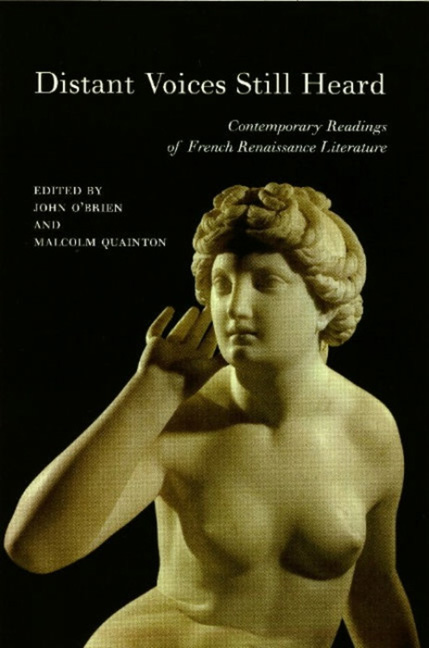Book contents
- Frontmatter
- Contents
- Editors’ Foreword
- Introduction: The Time of Theory
- 1 The Highs and Lows of Structuralist Reading: Rabelais, Pantagruel, chapters 10—13
- 2 Rabelais’ Strength and the Pitfalls of Methodology: Tiers Livre, chapters 7–18
- 3 ‘Blond chef, grande conqueste’: Feminist Theories of the Gaze, the blason anatomique and Louise Labé's Sonnet 6
- 4 Louise Labé's Feminist Poetics
- 5 Reading and Writing in the Tenth Story of the Heptaméron
- 6 Fetishism and Storytelling in Nouvelle 57 of Marguerite de Navarre's Heptaméron
- 7 Creative Choreography: Intertextual Dancing in Ronsard's Sonnets pour Hélène: II, 30
- 8 An Overshadowed Valediction: Ronsard's Dedicatory Epistle to Villeroy
- 9 ‘De l'amitié’ (Essais 1.28): ‘Luy’ and ‘Moy’
- 10 Montaigne's Death Sentences: Narrative and Subjectivity in ‘De la diversion’ (Essais 3.4)
- Select Bibliography
- Index
3 - ‘Blond chef, grande conqueste’: Feminist Theories of the Gaze, the blason anatomique and Louise Labé's Sonnet 6
- Frontmatter
- Contents
- Editors’ Foreword
- Introduction: The Time of Theory
- 1 The Highs and Lows of Structuralist Reading: Rabelais, Pantagruel, chapters 10—13
- 2 Rabelais’ Strength and the Pitfalls of Methodology: Tiers Livre, chapters 7–18
- 3 ‘Blond chef, grande conqueste’: Feminist Theories of the Gaze, the blason anatomique and Louise Labé's Sonnet 6
- 4 Louise Labé's Feminist Poetics
- 5 Reading and Writing in the Tenth Story of the Heptaméron
- 6 Fetishism and Storytelling in Nouvelle 57 of Marguerite de Navarre's Heptaméron
- 7 Creative Choreography: Intertextual Dancing in Ronsard's Sonnets pour Hélène: II, 30
- 8 An Overshadowed Valediction: Ronsard's Dedicatory Epistle to Villeroy
- 9 ‘De l'amitié’ (Essais 1.28): ‘Luy’ and ‘Moy’
- 10 Montaigne's Death Sentences: Narrative and Subjectivity in ‘De la diversion’ (Essais 3.4)
- Select Bibliography
- Index
Summary
The blason, the love poem written in praise of a woman's body, has been centralised in recent Renaissance studies through the work of Nancy Vickers, the first among feminist critics to theorise the psychosocial dynamics of this Renaissance genre. Feminist film theory of the 1970s and 80s, focused on the cinematic forms structured to gratify the male gaze, has also been enlisted to define the impulses driving the poet's ‘look’ at an iconic female body. The motives and processes of the masculine gaze posited by this psychoanalytically inflected line of thought are generalised across time by Luce Irigaray in her feminist deconstruction of the ‘scopic’ (visually oriented) sexual economy of Western culture, from Plato to Freud. One way to ground such theory in a specific historical situation is to trace out connections between sixteenth-century poetry and preaching, that is, to analyse lyric as a literary code operating among other discourses in the moralised gender system articulated in Renaissance conduct books for the middle classes, whose writers anxiously attempted to control how both sexes looked and saw. ‘Don't look now, or ever’ was the counsel of most writers on the proper behaviour of men, and even more, of women. The ideology, or belief system, underlying such advice surfaces in the poetry of the time as well, written by men and women in response – sometimes obedient, often challenging – to the conventions of seeing and being seen.
To understand the blason as a literary genre, I propose a composite approach. Beginning with feminist uses of Freud's insights into men's defence mechanisms and Irigaray's critique of a culture dominated by masculine ways of seeing, I will give these perspectives a local habitation by focusing on the literary texts produced by a bourgeois woman, Louise Labé, composing her sonnets in the merchant city of Lyons in the mid-sixteenth century.
- Type
- Chapter
- Information
- Distant Voices Still HeardContemporary Readings of French Renaissance Literature, pp. 85 - 106Publisher: Liverpool University PressPrint publication year: 2000



